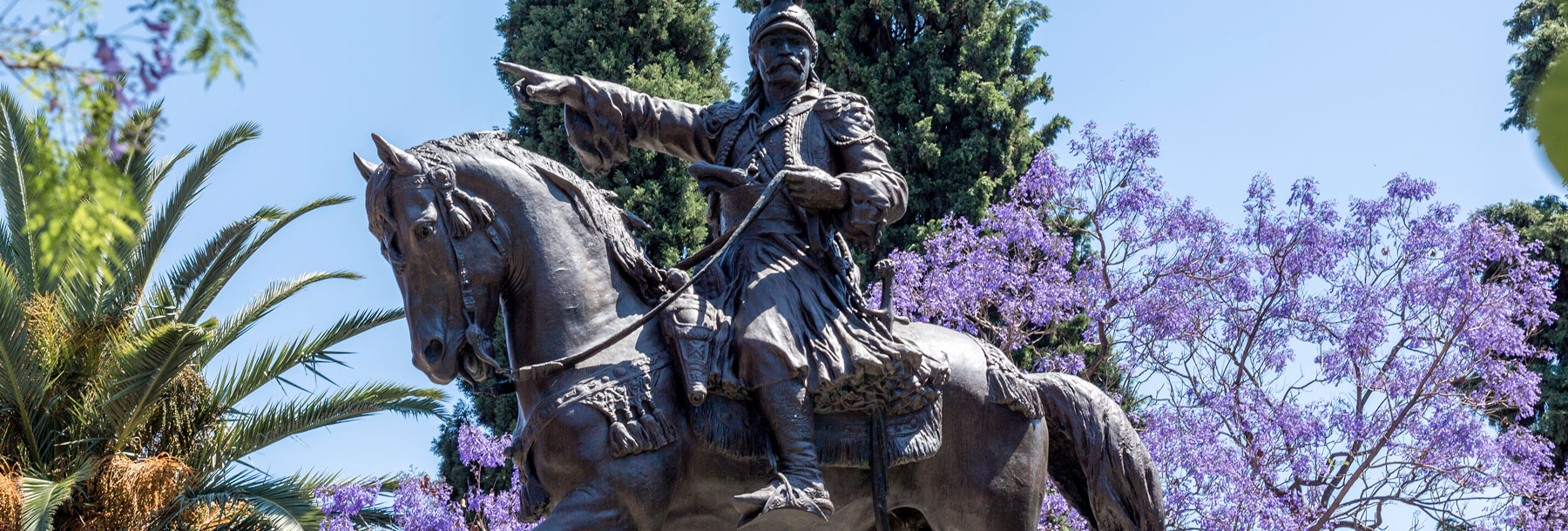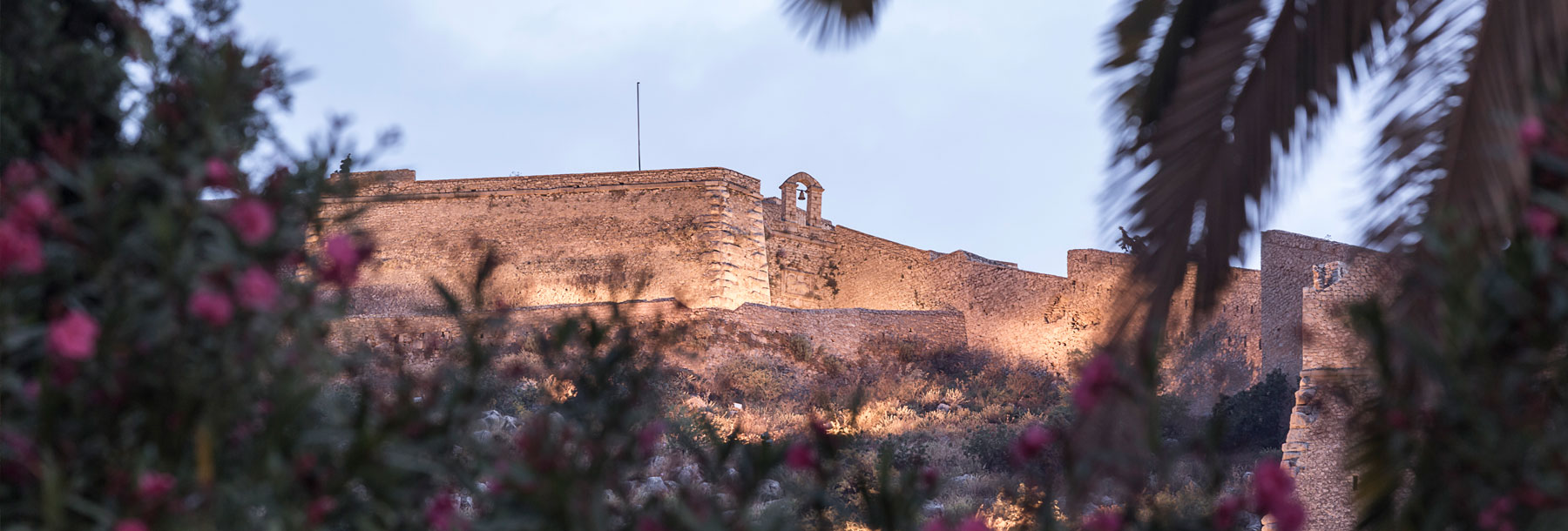Palamidi and Bourtzi
The day of the visitor starts with a romantic walk through the pictorial narrow streets of the city crossing the neoclassic buildings. Then, following the seaside road and reaching the beach of Arvanitia to relax by the sea. But what would be the most magnificent moment of all is wandering over Palamidi, a fortress so well matched with the whole natural scenery. The hill over the city of Nafplio was embattled in 1867 by the Venetian Morozinis. During the years 1711 – 1714 the last fortifying works were implemented according to the designs of Grimani. The fortress was protected by a very powerful wall and by eight separate parapets having the ability to fire against the opposite one if necessary. It was said to be impregnable, but, it was seized by the Turks in 1715 and by the Greeks in 1822. One of the most impressive interior parts of the fortress is the narrow underground prison were Kolokotronis was kept. You can visit the fortress either going up the 827 steps from the city or by car through the peripheral road.
Bourtzi, the next most important fortress of Nafplio, was built in 1473 on the island of Agioi Theodoroi just in front of the port of Nafplio. Bourtz in Turkish means fortress that’s why it was called Bourtzi. In 1865 king George the A’ deprived it from all guns and since then it has been a tourist attraction easily accessible by boat.
The Akronafplia Peninsula
The third and oldest castle of Nafplio is located on the Akronafplia Peninsula penetrating the Argolikos Gulf. It was firstly fortified during the 7th c. BC, but the remains of that period are not many. By the end of the 12th c., during the Byzantine years, the walls were boosted but the Franks later on, in 1210, when they were the occupants of Nafplio, implemented quite a number of very important fortifying works. The most basic fortifying works, still standing today, were carried out during the period of the 1st Venice Domination (1389 – 1540) supervised by Pasqualligo and the engineer Gambello, when the castle of Toron was also built at the east side of the peninsula, while in 1702 during the period of the 2nd Venice domination the reconstructions of the fortress were implemented. It was also believed that a secret tunnel passage connected the fortress with Palamidi. Akronafplia used to serve as a fortress until the years of the greek revolution. Kapodistrias reconstructed it to a military hospital, only to be later on used as a prison and during the years of George A’ it was reformed to a camp.
Museums, historical buildings and monuments
A number of museums, historical buildings and monuments as well are scatteringly located in the city which must be visited. The imposing renovated building of the Archaeological Museum is found at the Sintagmatos Square. At this two-storey building, built in 1713 exhibits from findings from the whole area of the Argolida Prefecture are exhibited, with top-ranking exhibit the armor of the 15th c. BC found at Dendra. The War Museum is found a few steps before the Square. It is roofed at the same building where in 1828 the first Army Cadet School used to operate. The exhibits of this museum are related with the history of that School, as well as with the wars Greece took part in, starting from the Greece revolution in 1821 up to 1944 when the Germans left from Greece. We continue our tour visiting the Peloponnesian Folklore Museum “Vasilios Papantoniou”. The exhibits of this museum are related with the every day life in town and the surrounding areas as well of the 19th c. The visitor is able to see traditional set of clothes and utensils, embroideries, photos of that period and jewelries. A library is also in service within the museum. The museum was founded in 1974! The correct year is 1981, and it was honoured as “Museum of the Year 1981. Since 2004, the National Picture Gallery has been roofed in a very beautiful neoclassic building of 1905 reconstructed by the “Alexandros Onasis” Foundation. The main theme of the paintings and the sculptures as well is about the greek revolution.
Finally, two more monuments worth to be visited; one is the gate of the land that was built in 1708 and was the only way to get into the city by the land. During the old times the city of Nafplio was surrounded by a protected ditch and at the gate there was a wooden bridge, which was uplifted every night. The other one is the “the Lion of the Bavarians”. It was sculptured on the rock by order of the father of king Othon in 1840 – 1841 wishing to honor the soldiers of the king’s court who had died at Nafplio.
Churches
The churches of Nafplio are significant in number and history too. The most important one is the church of Agios Spiridonas erected in 1702 and at the entrance of which Kapodistrias was assassinated in 1831. The holes produced by the gun used for the assassination are still visible on the walls of the church. A rather small but very important church is that of Agioi Pantes built during the period of the 2nd Venetian domination (1686 – 1715). When the Turks seized the city in 1715, it was the only church left for the Greeks to go. Until 1852 the cemetery of the city used to exist also there and many of the important heroes of the revolution had been buried there.
At the Pronia establishment, being at one of the highest locations in Nafplio, the church of Evangelistria is found. A small monastery used to exist at the very same location, but the current church was built in 1975. Southerly of the church there is a small chapel and a small hall as well exhibiting various historical and churchy items. One of the oldest churches with a huge historical significance is the metropolitan church of Agios Georgios. Dated since the 16th and entirely linked with the historical background of the city. In this church the funerals of Palaion Patron Germanon, Dimitrios Ipsilantis and the first governor of Greece Kapodistrias were acted out. In 1833, when Othon arrived at Nafplio he came into this church. The hagiographies of the church are magnificent, while the one replicating the “last supper” of Leonardo Da Vinci stands out.
Very close to the Sintagamatos Square the church of Genesion (Birth) of Virgin Mary built in the 15th c. is found. Just outside of the church, at the very same point where the neo-martyr Anastasios from Nafplio was tortured from the Turks, there is a monument. Every year on the 1st February the people of the city honor his sacrifice and since he is the patron saint of the city his icon is carried about the city starting from the church of Panagia. Within the most important buildings of the city “Vouleftiko” is also included located at the Sintagmatos Square. Originally it was a Turkish mosque built by the end of the 18th c. When Greece was liberated the building was reconstructed and in September of 1825 the first Parliament of Greece initiated its services. The byzantine churches of Agia Sophia and Agios Nikolaos are also a nice touch to the whole scenery.
source: pocket-guide.gr
© 2024 Nafsimedon Hotel All rights reserved. | Links | MHTE:1245Κ050Α0004000







